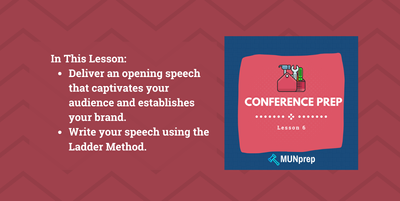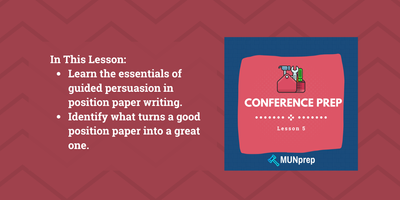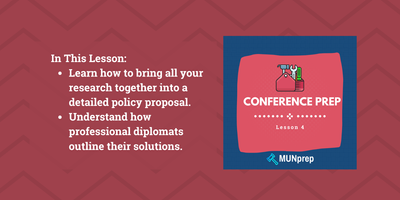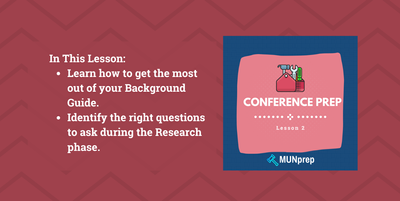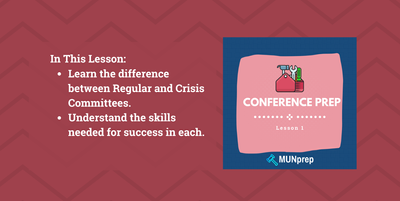MUN Research Essentials - Two Steps to Success
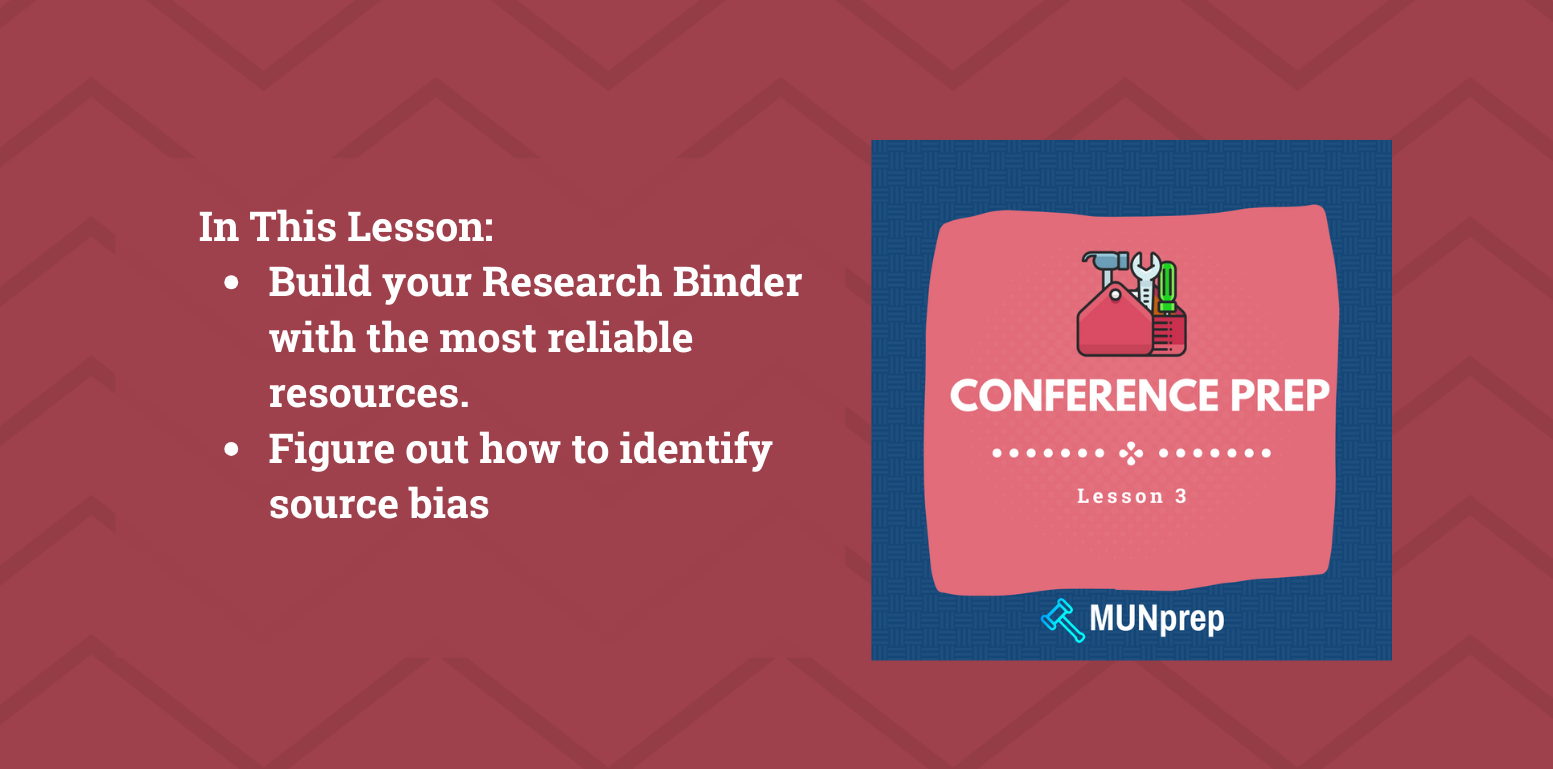
Knowing exactly where to start with research is a challenge - many delegates risk spending too much time looking into the wrong things and struggle to find reliable sources.
You can end up spending twice as much time trying to gather information for half the benefit, and this can make your conference prep experience feel like an absolute chore.
Today, we're going to show you everything we use to help our students get ready for conferences, starting with our super simple 2-step approach. We'll show you exactly what to look for and how to build an awesome research binder.
Let's get started.
Model UN Research
Research is my favourite part of the conference prep process - its where I'm able to become an expert on my committee and learn about amazing projects that people are working on to make the world a better place.
I get to learn about a number of different ideas, see what works, and what hasn't. At the very end, I can bring all that information together and put my own unique spin on things.
As you will soon find out, research is the backbone of your conference prep process - it's what fuels debate throughout the entire weekend and helps push a resolution across the finish line. The Chair will always be looking for a delegate who has done their research and knows how to use it effectively.
We are officially in stage 2 of the conference prep funnel:

Your Research Journey - Visualized
We'll move through each stage of this chart over the course of this guide. At this point all you need to know is that your research journey starts with choosing a few areas of interest, you then figure out which areas of interest work well with your country policy.
At the very end you put together a short 'research report' where you bring in your own ideas and sources to back those ideas up.

How to get started
Assuming you've completed our lesson on background guides, you should now have the following:
Our next goal will be to turn those areas of interest into actual research questions. Once you've found out what your priorities are, your research process will become much easier.
Picking Your Sources
You should always look for sources that are:
- Credible
- Balanced
- Up-to-date
We've provided a list of reliable starter research resources you can use here. But just remember, even in MUN make sure to back up your ideas with reliable sources.
If you end up using your own sources, always remember the Credible Hulk.

Not every source is created equal, some of them might suffer from 'source bias'.
Identifying Source Bias
Even high-quality sources can have biases based on their funders, stakeholders, or political affiliations. Pay attention to the language used—if it’s excessively opinionated or one-sided, the source might be pushing a particular viewpoint.
Compare coverage of the same topic from multiple outlets to see if there are differences in fact selection or framing.
Checking the author’s background, potential conflicts of interest, and the organization’s mission can help you detect possible bias.
In general, identifying source bias won't be too difficult, if you've conducted enough research in your interest area, you'll comfortably be able to spot when something sounds a bit off. By staying aware of these risks, you can critically evaluate the information you gather and build stronger, more balanced arguments.
The 2 Stage Research Process
Step 1 - Identifying your Focus Question
Your focus questions are the specific issues you are trying to solve. The purpose of a background guide is to break down a big problem into manageable sub-topics.
- If you just start googling 'how to end world hunger', you're not going to get very far.
- But if you search instead for 'sustainable farming practices for rural communities', you're going to have much more success.
Here's how you can figure out your own focus questions:
- Read the 'focus questions' section of your background guide (if your guide has one).
- Create a list of recurring themes that you identified throughout your background guide.
- Look and see if your topic area relates to any of the sustainable development goals.

Just remember, identifying your focus questions is personal to you - figure out what you are most interested in and would like to learn more about.
The best part about Model UN that there are so many subtopics to explore, you will always find something that works for you. Becoming a specialist in a certain area is a key part of the persuasion triad, and will give you far more credibility.
You don't need to solve every single problem yourself, in MUN you are allowed to focus on certain issues more than others. As you start working with other delegates in your committee, you will find delegates with complimentary solutions and you'll be able to work together. By working together you can incorporate their approaches with yours and make a high quality resolution.
The specificity of your focus questions is important - it will help you avoid finding useless sources that you won't end up needing. If it helps, try and break down your focus question into sub-themes and see if you can find information related to each.
Don't worry about making every focus question perfect - we're going for a quantity over quality approach at this stage, so just think of 4-5 different research questions at this stage and refine them during the next stage.
Are you in a Double-Delegate committee? Have one partner contribute half of the research questions for each topic - try and avoid making one team member a specialist on each topic.
For example, if your focus question is “How can we strengthen cybersecurity in global financial systems?”, sub-themes might include:
“What are current vulnerabilities in international banking networks?”
“How can public-private partnerships improve cybersecurity measures?”
Example Focus Questions:
Delegation: Iceland - Topic: Overfishing

Step 2 - The Research Process
At this stage, you should have:
- Your background guide notes
- 4-5 focus questions with any sub-topics.
If you have all that, you're ready to keep going.
2.1 Focus Question Analysis
Next we need to figure out what resources do we have available that can help us solve each individual problem?
The goal here is to whittle down your focus questions into 2-3 areas that look more promising.
Your goal here should be on building a short research report on your country for your focus areas, this should include things like:
What you should be looking for at this stage is figuring out:
- Do any focus areas seem more promising than others?
- What organizations do you have at your disposal?
- What projects are underway?
- What seems most interesting to you?
Now that you understand where your country stands on things - it's time for the deep-dive.

2.2 Deep Topic Research - Feasibility Analysis
By this stage you should have:
- Detailed background guide notes
- 2-3 refined focus questions that align with country policy.
- A short report (1-2 paragraphs) with additional context for each of your final focus questions.
Now it's time to go in depth, and turn your research into ideas.
Your Turn - What's Your Take?
In Model UN, you're not just there to repeat what's already been done—you’re encouraged to bring your own perspective to the table. Conferences are an opportunity to suggest creative new approaches and explore fresh solutions to real-world problems.
So, how do you start developing your own ideas?
Think critically about what actions you believe could make a real difference. It’s okay to think outside the box—some of the best ideas start with bold thinking!
Look for similar strategies that have worked in the past, or data that backs up why your solution could succeed. Combining your creativity with solid evidence will make your ideas stand out.
Remember, MUN is as much about innovation as it is about collaboration. Your unique perspective could inspire others and lead to impactful discussions. So don’t hold back—let your research spark your imagination!
Creative solutions have the power to offer fresh perspectives on complex global issues. They can catch the attention of delegates and the dais, demonstrate your ability to think outside the box, and distinguish your position from others.
Your Ideas Matter
Although Model UN is only a simulation of the actual UN, you might assume that your resolutions won’t go much further than the committee room.
But in reality, UN committees have reviewed and even incorporated solutions originally proposed at MUN conferences into their own resolutions. Conferences like THIMUN also submit their top resolutions to an actual UN review panel for further consideration.
Organizing Your Report
At this point, your research can go as deep as you want, look into a few different ideas for each focus question.
Include context on why you think each idea might work and list any sources that you are using and what valuable information you found in the source.
All of the sources you keep will eventually form a valuable part of your research binder.
Try find facts and figures that support your arguments, maybe a few inspirational quotes, and anything else that you can use in your speeches during the conference.
Your report should look like this:

Coming up with Creative Solutions
Here are a few tips on how you can come up with more creative solutions on your own:
- Research extensively: Deepen your understanding of the topic by conducting thorough research. Explore case studies, and real-world examples that can inspire creative thinking and provide valuable insights.
- Be open-minded: Cultivate an open and receptive mindset that welcomes new ideas and alternative viewpoints. Avoid dismissing ideas too quickly and be willing to adapt and modify your own proposals based on constructive feedback.
- Collaborate: Work with your teammates. Delegates working on other topics can provide interesting insights that you can bring to your own research.
- Consider long-term impacts: Look beyond short-term solutions and consider the long-term effects of your proposals. The UN's problem-solving approach always looks to think about things like sustainability, social impact, and the potential for transformative change in your solutions. This extra perspective can help you to approach the issue in a way that other delegates may not.
Next Lesson
Congratulations! You've now completed the stage that can normally be the most time-consuming for new MUN delegates, many students can get lost in a vortex of information and not be quite sure as to what information is useful or not.
Always remember - stick with your focus questions and it'll help you avoid getting lost.
Now that you have all this information well organized, it's time to move on to the next stage where we turn these wonderful ideas into a proper policy proposal that you can write about in your position paper and pitch to delegates in-committee.
See you there!



